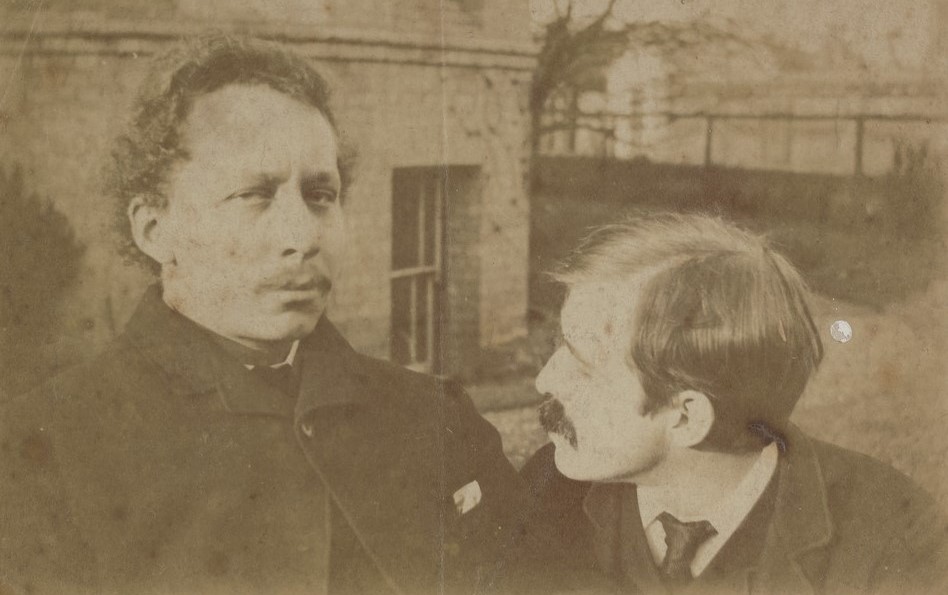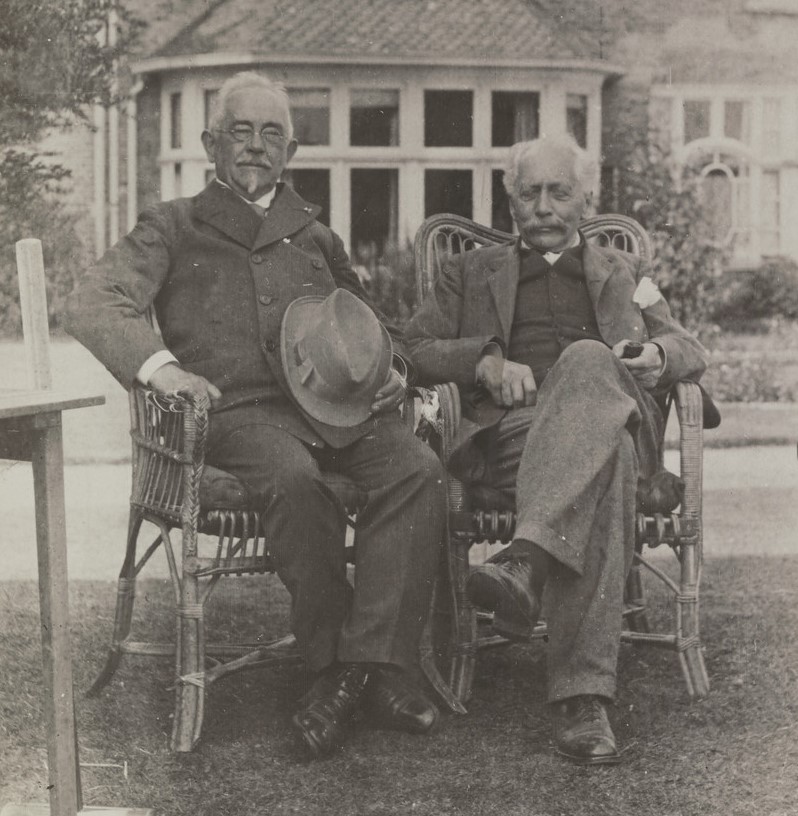The "Secret" Relationship between
Motoo Kimura and Gregory Bateson
Contents
◆ "One scholar"?
When I read Gregory Bateson’s article “The Role of Somatic Change in Evolution” in Steps to an Ecology of Mind, I thought for a while that it was original and lucid, but that it probably did not influence mainstream evolutionary theory or genetics. However, I was reading a book and noticed that a surprising scholar seemed to be referring to it. The book was My Thoughts on Biological Evolution by Motoo Kimura, famous for his Neutral theory of molecular evolution. In the first chapter of the book, “Diversity of Organisms and Views on Evolution,” Kimura writes in the section titled “History of the Development of Evolutionary Theory” as follows:
In addition, one scholar has raised the following objection to the claim that acquired characters are inherited. In general, the morphological and physiological properties of an organism (in other words, phenotype) are not 100% determined by its set of genes (more precisely, genotype), but are also influenced by the environment. Moreover, the existence of phenotypic flexibility is important for an organism, and adaptation is achieved just by changing the phenotype. If by the inheritance of acquired characters such changes become changes of the genotype one after another, the phenotypic adaptability of an organism would be exhausted and cease to exist. If this were the case, true progressive evolution, it is asserted, could not be explained. This is a shrewd observation. Certainly, one of the characteristics of higher organisms is their ability to adapt to changes of the external environment (for example, the difference in summer and winter temperatures) during their lifetimes by changing the phenotype without having to change the genotype. For example, the body hair of rabbits and dogs are thicker in winter than in summer, and this plays an important role in adaptation to changing temperature.
From My Thoughts on Biological Evolution. Motoo Kimura.
This sentence can be read as a partial summary of those mentioned above, “The Role of Somatic Change in Evolution.” In fact, Gregory Bateson criticized the theory of inheritance of acquired characteristics in that paper, and I can cite passages from it similar to those written by Kimura.
From these considerations it follows that if evolution proceeded in accordance with conventional theory, its process would be blocked. The finite nature of somatic change indicates that no ongoing process of evolution can result only from successive externally adaptive genotypic changes since these must, in combination, become lethal, demanding combinations of internal somatic adjustments of which the soma is incapable.
From “The Role of Somatic Change in Evolution” in Steps to an ecology of mind. Gregory Bateson.
Gregory Bateson wrote it in 1960 and published it in Evolution in 1963. It is natural to assume that Kimura, who studied population genetics in the U.S. from 1953 to 1955, continued to read this journal on evolutionary theory written in English after he returned to Japan.
However, if there’s one thing I’m somewhat curious about, why did Kimura withhold the author’s name of the theory that made him say, “This is a shrewd observation” as “one scholar”? Even though Kimura introduces many biologists by their full names in the same book. Is it because Kimura did not consider Gregory Bateson, who is often introduced as an “anthropologist” or a “philosopher,” to be a “legitimate” biologist? Or was it too much trouble to explain about this scholar who has traversed many fields of studies? Or did they simply lose track of the name? Or was it because he was the son of William Bateson?

A photo of William Bateson (L) and Weldon (R) together. It is thought to be from before the controversy.
From the Bateson Archive, University of Cambridge Digital Library.
The population genetics that Kimura studied is also called the “revived biometric school.” Walter Frank Raphael Weldon, the biometric school leader, and William Bateson, who defended and popularized Mendel’s laws of heredity and created “genetics,” were friends, but they later had a fierce dispute.
In My Thoughts on Biological Evolution, Kimura writes:
After Weldon’s death, the Weldon prize was established at Oxford University in his memory, which is awarded once every 3 years to the scholar making the greatest contribution in the world to the field of biometrics.
From My Thoughts on Biological Evolution. Motoo Kimura.
He also took the trouble to post a photo of the Weldon Medal.
And he writes in The Neutral Theory of Molecular Evolution:
As one who has been honored by the Weldon Memorial Prize, I feel a particular interest in Weldon’s life
From The Neutral Theory of Molecular Evolution. Motoo Kimura.
◆ Who is Weldon? Biometric school and Mendelian school
The following is about Weldon, whom Kimura says, “I feel a particular interest.”
As William B. Provine writes in his book The Origins of Theoretical Population Genetics, Weldon and William Bateson have a lot in common in their academic backgrounds. Both of them were influenced by F. M. Balfour and studied evolution from the perspective of development and morphogenesis based on the idea of so-called “ontogeny recapitulates phylogeny.” However, they felt that they had reached a limit. After reading F. Galton’s Natural Inheritance, they expected that the study of evolution would be shed light by statistically investigating populations.
However, the fundamental difference was that Weldon, like Darwin, believed that evolution was continuous, while William Bateson, like T. H. Huxley and Galton, thought evolution was discontinuous.
The controversy between the two began even before Mendel’s paper was rediscovered. Weldon realized the importance of statistical mathematics but admitted that he did not have a deep background in it. He invited Karl Pearson, an applied mathematician, to join him. Pearson was so interested in Weldon’s work that he began to research evolution. Thus, the so-called biometric school was established. Like Darwin, this school believed that evolution occurs through natural selection on “continuous and minute differences.” They also thought the “Law of ancestral heredity,” which Galton had proposed before rediscovering Mendel’s paper, was correct.
At first, Weldon was quick to rejoice, convinced of their methodology’s correctness and future “victory,” but he soon hit a dead end. According to Weldon’s biography by Pearson, he created the concept of “death-rate” to explain the “small number of intermediate types,” in other words, “dimorphism,” that somehow statistically appear in each generation of organisms. And he tried to prove it through experiments.
He caught a large number of the same generation of a particular species of crab living in the Mediterranean Sea and measured the size of each carapace. He found that the population was divided into two types: large and small carapaces, for some reason, with a small number of intermediate sizes. Weldon thought that the reason why there were so few intermediate forms was that they died.
Weldon measured the death-rate by placing many glass jars containing seawater and a single crab of various sizes. Pearson called the device “Crabbery” and even included a picture of it in Weldon’s biography, probably because the rows of glass jars filled with crabs looked like a berry. If Weldon’s hypothesis is correct, individuals with intermediate carapace sizes should somehow die earlier than those with larger or smaller carapaces. In other words, their death-rate should be higher.

A photo of “Crabbery.”
From Pearson, K. 1906. Walter Frank Raphael Weldon 1860-1906: A Memoir. New York: Cambridge University Press.
In the end, however, there was no difference in the death-rate.
Of course, Weldon’s above experiment does not effectively prove the existence of natural selection or the difference in death-rate. It does not explain the phenomenon of a statistically small number of intermediate forms when measuring crabs’ shells. In the end, Weldon explained that the crabs’ habitat had been altered by environmental destruction, such as the accumulation of mud, and that this had affected their life. But of course, this is not very convincing. They also found apparent dimorphism in the herring body’s width and the ray florets of ox-eyed daisies. The methodology they believed in could explain neither; Weldon was severely disappointed by these results. Pearson also wrote that the dimorphism in the ray florets of ox-eyed daisies could not be attributed to environmental or seasonal effects at all. According to Pearson, nothing was ever written about herring and ox-eyed daisies.
According to their belief, statistical studies could prove the correctness of Darwin’s theory. But they could not successfully explain evolution or even the dimorphism in a generation. The statistical fact that dimorphism in nature was a significant obstacle to the school that thought can prove Darwin’s theory by statistical research. Weldon came to a dead-end before Mendel’s laws of heredity to be proven.
Weldon then statistically studied the number of rolls in the terrestrial snail’s shells. And he found that individuals with too many or too few rolls than average had a high death-rate. This study is described as an example of so-called “stabilizing selection.” Weldon has finally found a case that can be explained by death-rate and selection.
Looking over Weldon’s series of studies, it seems that when there is “one statistical mountain,” the theory of death-rate and selection explains it well. Still, when there are “two statistical mountains,” the theory does not. If you measure the number of rolls on the snail’s shell and calculate the statistics, the graph will look like “a mountain.” On the other hand, if you measure the size of a crab’s shell and calculate the statistics, the graph will look like “two mountains.” So the theory of death-rate and selection could only explain the former well. However, if a theory could explain the one or two statistical mountains equally well, this theory would have a higher scientific universality than Weldon’s theory. Therefore, this theory would be more suitable as a scientific theory.
Later, William Bateson and his collaborators realized the importance of the rediscovered Mendel’s laws of heredity. And they began to demonstrate that the laws applied to a wide range of plants and animals. Mendel’s laws could explain the small number of intermediate forms that Weldon’s theory could not explain. While Weldon thought that there are so few intermediate forms because they are born and then die for some reason, Mendel’s law explains why there are so few of them in the first place. However, Weldon refused to admit this and began to spend much of his time and energy criticizing Mendel’s theory.
According to Pearson, Weldon preferred to move by bicycle. 1906, C. C. Hurst noticed that genetic examples of horse coat color in the General Stud Book of Race Horses followed Mendel’s laws and discussed and published them. Then Weldon, as usual, rode his bicycle to visit horse farms here and there, gathering materials to disprove Hurst’s claim. Perhaps due to fatigue, Weldon caught the flu in the process, and despite Pearson’s advice to rest, he went out again and died suddenly of pneumonia.
About after that, in his Neutral Theory of Molecular Evolution, Kimura writes:
After Weldon’s death, biometricians were in retreat and the victory of Mendelians was soon evident, being supported by overwhelming facts.
From The Neutral Theory of Molecular Evolution. Motoo Kimura.
This is the view of Provine’s book mentioned above, and Kimura himself writes:
The exciting but confusing atmosphere of this period is well described by Provine (1971).
From The Neutral Theory of Molecular Evolution. Motoo Kimura.
As he wrote, he inherited Provine’s view. However, Kyung-Man Kim later criticized Provine’s view in Explaining Scientific Consensus: The Case of Mendelian Genetics (1994). According to Kim, the biometric school did not immediately decline after Weldon’s death, but there was a movement afterward around the “pure line theory” proposed by Wilhelm Johansen.
According to the biometric school’s belief, genetic material is liquid and quantitative, as Darwin thought. Therefore artificial selection, especially “mass selection” to select phenotypes, should have moved the mean of traits in a population as desired. However, this did not happen.

A photo of Johansen (L) and William Bateson (R) together, 1923.
From the Bateson Archive, University of Cambridge Digital Library.
In the case of self-fertilized plants, the effect of selection is lost when the “pure line” is reached, and in the case of other cross-fertilized organisms, when the “pedigree line” is reached.
One after another, the biometricians admitted the correctness of the pure line theory and Mendel’s theory through experiments. One of them is G.H.Shull, famous for establishing “hybrid vigor,” which dramatically increases the yield of corn. Hybrid vigor is a breeding method based on pure line theory and Mendelian theory.
Rather than simply switching schools, they simply acknowledged the pure line theory and Mendel’s law’s correctness but were “expelled” from the school by an angry Pearson. This pattern continued several times so that the biometric school became less a school and more Pearson himself.
According to Kim, Pearson admitted that at least the “law of segregation” was correct to some extent among Mendel’s laws. But in the end, he did not accept Mendel’s theory itself until his death.
William Bateson, the winner of the controversy, named his third son after Mendel’s baptismal name, Gregor, who was born in 1904 during the debate. That son was Gregory Bateson.
In other words, Kimura may have had something to the son of William Bateson, an opponent of Weldon whom he respected. I am inclined to think that this is why he withholds the scholar’s name mentioned above as “one scholar.”
◆ Gregory Bateson's paper The Importance of Somatic Cell's Flexibility
It brings me back to Gregory Bateson’s paper.
I’m going to try to explain the purpose of this paper in my way.
This paper’s unique aspect is that it considers evolution focusing on “somatic cells” or “phenotypes.” In contrast to, for example, Richard Dawkins’s “the selfish gene theory,” which considers the genes as the center and commander of life. In Dawkins’s theory, an organism’s phenotype, including its form, is created in a top-down fashion from its genes. However, Gregory Bateson puts the somatic cells, not the genes, at the evolutionary process center. And he is saying that environmental changes and genetic mutations are both stressful to the somatic cells. Environmental changes are stresses from “outside,” and genetic mutations are stresses from “inside,” and somatic cells have to cope with both stresses. He first argues that somatic cells need to be flexible at all times.
From this perspective, Gregory Bateson criticizes both the Lamarckian theory of inheritance of acquired characteristics and the selectionistic “synthesis of evolutionary theory” of the time, almost simultaneously, in a single paper. He says that both of them are wrong from the perspective of somatic flexibility. Because if the mechanism each of them advocates progresses, somatic cells are going to eventually lose all their flexibility, and if this happens, evolution will have to stop.
In My Thoughts on Biological Evolution, Kimura’s description mentioned above seems to summarize Bateson’s criticism of the theory of inheritance of acquired characteristics.
For Gregory Bateson, the inheritance of acquired characteristics means that changes in somatic cells’ flexibility can be controlled by genes. However, genetic control has no so-called “plasticity.” In the case of somatic changes, there is plasticity, and when they are no longer needed, generally, they return to their original state. However, when genes control such things, it is not possible to say that the phenotypic change is not necessary because it is not needed.
Gregory Bateson gives as an example the response of the respiratory and circulatory systems when we move to higher altitudes and when we return to lower altitudes.
For example, when you move to a higher altitude, you may initially gasp at the low oxygen density, but your respiratory and circulatory systems will gradually adjust. At this time, the gene itself has not mutated to respond to the situation, but it is reacting somatically. When you move to lower altitudes again, the high oxygen density becomes a burden to your body at first, but you get used to it after a while. It is because somatic changes are plastic.

But let’s say that the results of responding to high altitudes become genetically controlled, in short, fixed as a characteristic, which then passed on to the offspring. In other words, the acquired characteristics are inherited. Then, the child’s respiratory and circulatory systems are fixed from birth in response to the low oxygen density at high altitudes, making it difficult to move to lower altitudes. If the characteristics were not genetically fixed, the child would be able to cope with both high and low altitudes. However, because it is genetically fixed, it loses its somatic flexibility.
Besides, if this were to continue from generation to generation for other characteristics, the organism would eventually lose its total somatic flexibility. The organism that loses its whole somatic cells’ flexibility will have no way to respond to new environmental changes and die. That’s why he says it’s a bad idea for acquired characteristics to be inherited. For Gregory Bateson, the inheritance of acquired characteristics is not a “mechanism of evolution” but a “mechanism that stops evolution.”
I guess Kimura may have read the paper and wrote, “This is a shrewd observation.”
In the same paper, Gregory Bateson criticizes the synthesis of evolutionary theory in what sense? The synthesis of evolutionary theory is exactly what was established through the debate mentioned above between the Mendelian and biometric schools. This theory was based on the idea that genetic mutations and natural selection on phenotypes were the leading evolution mechanisms. And they thought that most of the gene mutations would be phenotypically disadvantageous to the selection, and only a few would be advantageous.
From a somatic cell (phenotype) perspective, these gene mutations are also stresses. This is because the body of an organism is forced to adjust various variables to respond to any changes that occur in the somatic cells. And the more they respond, the less flexible body cells become. The following is a description of the problem and how to deal with it by Gregory Bateson.
Another aspect of the proposed hypothesis about which we can only speculate is the probable relative frequency of the two classes of genotypic change: those which initiate something new and those which affirm some homeostatically achieved characteristic. In the Metazoa and multicellular plants, we face complex networks of multiple interlocking homeostatic circuits, and any given mutation or gene recombination which initiates change will probably require very various and multiple somatic characteristics to be achieved by homeostasis. The hypothetical pregiraffe with the mutant gene “long neck” will need to modify not only its heart and circulatory system but also perhaps its semicircular canals, its intervertebral discs, its postural reflexes, the ratio of length and thickness of many muscles, its evasive tactics vis-à-vis predators, etc. This suggests that in such complex organisms, the merely affirmative genotypic changes must far outnumber those which initiate change, if the species is to avoid that cul-de-sac in which the flexibility of the soma approaches zero.
From “The Role of Somatic Change in Evolution” in Steps to an ecology of mind. Gregory Bateson.

Suppose a mutation occurs in the genes of the “pregiraffe,” which may be the predecessor of the giraffe, causing its neck to lengthen. But if this happens, all the somatic cells involved in the skeletal system, muscular system, respiratory system, circulatory system, nervous system, etc., will have to change together “somatically” to accommodate the lengthened neck. This is because there is no convenient genetic mutation that can change them all at once and just right. And when they do, the somatic cells’ flexibility will be significantly reduced.
And if many such gene mutations occur, the somatic cells’ flexibility will be quickly eaten up.
Therefore, it is not just a matter of innovative genetic mutations. He says that for somatic cells to remain flexible, the number of “the merely affirmative genotypic changes” must be much higher than the number of innovative genotypic changes at the genetic level.
Here we notice that the “the merely affirmative genotypic changes” described by Bateson are quite similar to Kimura’s “gene mutation neutral to selection.” Because the merely affirmative genotypic changes do not change the organism in any way, it does not make the organism’s phenotype more or less favorable to selection. In other words, it is “neutral” to selection.
◆ What is "neutral evolution theory"? Paradigm shift
To begin with, what is Kimura’s “neutral evolution theory”?
There are two core elements to this theory.
The first is the assertion that “at the genetic level, many mutations occur that do not favor or disfavor phenotype over the selection, i.e., ‘neutral mutations to selection.’”
The second is that “the neutral mutations in a gene can spread through a population by a mechanism called ‘genetic drift.’”
What Bateson writes is very similar to the first of these claims.
So, was Gregory Bateson influenced by Kimura’s “Neutral Evolution Theory” when he wrote this?
As mentioned above, Bateson wrote this paper in 1960, and it was published in Evolution in 1963.
On the other hand, according to Kimura’s description:
In order to explain these unexpected results from the standpoint of population genetics, the conclusion I reached in 1967 was that it was necessary to postulate an important role for random drift of mutations, neutral under natural selection, in evolution at the molecular level. After reporting this idea (the neutral theory) at the Genetics Club Meeting in Fukuoka in autumn, I prepared a brief communication and submitted it to the English scientific journal Nature around the end of the year; fortunately it was accepted and published in February of 1968.
From My Thoughts on Biological Evolution. Motoo Kimura.
To put the timeline in perspective.
1960, Gregory Bateson wrote “The Role of Somatic Change in Evolution.”
1963, the paper was published in Evolution.
1967, Motoo Kimura reached the neutral theory.
1968, Kimura’s paper on the neutral theory was published in Nature.
It turns out that Gregory Bateson’s writing about “the merely affirmative genotypic changes” was not influenced by Kimura. On the contrary, five years before Kimura published his theory in Nature, Gregory Bateson had said almost the same thing about a genetic mutation in a paper published in Evolution. And the fact that Kimura seems to have read that paper is shown in the discussion above.
I want to say that Gregory Bateson stated the same thing semantically as “neutral genetic mutation” before Kimura did. Besides, the possibility that the world-famous author of the “neutral evolution theory,” Motoo Kimura, may have been greatly inspired by Gregory Bateson’s original paper.
I have written about my reasons for thinking so, and I’ll list them in bullet points.
・In My Thoughts on Biological Evolution, Kimura’s article can be read as a partial summary of Gregory Bateson’s paper, so it seems likely that Kimura has read it. However, Kimura withholds the scholar’s name who writes the paper as “one scholar,” so there is no proof.
・In his paper, Gregory Bateson’s assertion that “the merely affirmative genotypic changes must far outnumber those which initiate change” is roughly equivalent to one of the core elements in Kimura’s theory of neutral evolution.
・Gregory Bateson’s paper was published in a journal five years before Kimura’s “Neutral Evolution” was published.
These are the reasons why I think as above.
If this is true, it means that Bateson’s paper has not just had no impact on evolutionary theory and genetics, as I thought when I first read “The Role of Somatic Change in Evolution.”
According to From Selectionism to Neutralism: Paradigm Shift of Evolutionary Studies. 自然淘汰論から中立進化論へ:進化学のパラダイム転換(Naruya Saitou), there were several scholars before Kimura who argued for a theory similar to Kimura. However, Saitou does not include Gregory Bateson among them.
Yoshiaki Sato, the Japanese translator of Steps to an Ecology of Mind, wrote about the paper:
This paper argues that orthodox evolutionary theory at the time unjustifiably ignored the importance of ‘somatic changes’ acquired by individuals living in the environment. It is equivalent to asserting the importance of the individual organism that lives independently in the overall flow of life. In opposition to the crude mechanistic view of life, he offers a finely tuned path of thought about “evolutionary systems.” He is not developing a single “Batesonian evolutionary theory” here. He raises a fundamental question that should be unavoidable for all evolutionists and gives what he believes to be the best answer to it. In that sense, this theoretical reflection has a timeless validity.
From a commentary of the Japanese translation version
“The Role of Somatic Change in Evolution”
in Steps to an Ecology of Mind. translated by Yoshiaki Sato.
On the other hand, Kimura himself wrote about the submission of the neutral theory:
In this way the neutral theory was for me something that I proposed, compelled by theoretical necessity as entailed by an analysis of observed data; however, as one brainwashed by the synthetic theory of evolution, it was emotionally difficult for me to accept the neutral theory that I had put forward.
From My Thoughts on Biological Evolution. Motoo Kimura.
However, suppose Kimura had read Gregory Bateson’s paper, as Sato says, it “raises a fundamental question that should be unavoidable for all evolutionists,” and its arguments were convincing. In that case, it seems that this paper may have been one of Kimura’s triggers to remove his “brainwashing” by the synthesis of evolutionary theory at the time.

Bronze statue of Motoo Kimura in Okazaki City from Wikipedia
I conclude my discussion of the “secret” relationship between Motoo Kimura and Gregory Bateson.
2021 3.30 writing
2021 6.24 modify
2021 10.7 modify
◯References
Bateson, Gregory. 2000. Steps to an ecology of mind. Chicago: University of Chicago Press.
グレゴリー・ベイトソン 2000『精神の生態学』改訂第2版・佐藤良明(訳)新思索社
Kimura Motoo. 1983. The Neutral Theory of Molecular Evolution. New York: Cambridge University Press.
◯Bibliography
Saitou Naruya. 2009. From Selectionism to Neutralism: Paradigm Shift of Evolutionary Studies. Tokyo: NTT Publishing.
(斎藤成也 2009『自然淘汰論から中立進化論へ―進化学のパラダイム転換』NTT出版)
◯Reference website
University of Cambridge Digital library: Bateson archive
品種育成法の実際 Actual breeding methods
A site that explains various breeding methods.(Japanese)
「ハイブリッド・コーン」というイノベーション(1) Innovation of “hybrid corn”(1)
A site that explains Shull’s “hybrid vigor” from the perspective of innovation.(Japanese)
※The content, text and images are prohibited to reproduce, quote or use in any way other than for correct quotation.






